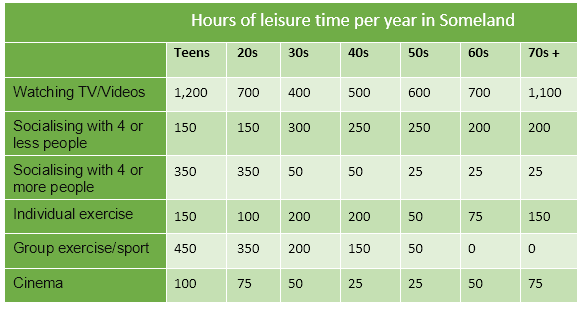» You should spend about 20 minutes on this task.
The table below gives data on the hour of leisure time per year for people in Someland.
Write a report for a university lecturer describing the information in the table below.
» You should write at least 150 words.

Sample Answer 1:
The data presented in the table outlines how much leisure time people from different age groups spend yearly in Someland. It is obvious that watching TV is a popular form of free-time activity for Somelanders.
According to the figures, watching TV is a common recreation among people in Someland, teenagers and elder people watch TV even more. They spend over a thousand hours per year to watch different TV programmes while it ranges from 400 to 700 hours among others. Young people have more friends to socialize while this number decreases when they grow up. Teens spend as much as 350 hours socializing with 4 or more friends while it is only 25 to 50 hours for adults and elders. On the contrary, people in their thirties spend the highest time socializing with fewer people. Individual exercise is preferred by people in their 30s and 40s while group exercise is more popular among teenagers. Elder people mostly refrain from doing exercises in their free time. Watching cinema is not a common leisure activity among Somelanders and teenagers spend 100 hours doing so which is higher than time spent in this pursuit by citizens of other ages.
Sample Answer 2:
The table shows how people in different age groups spend their leisure time in Someland over the course of a year. Overall, the amount of leisure time available varies considerably across the age groups and people of different age levels have very different ways of spending their leisure time.
According to the figures, as people age in Someland, their time for socialising reduces. Teenagers and people in their twenties spend around 500 and 350 hours per year on socialising with a group of more than 4 people. Although the total hours of socialising in their 30s, 40s, 50s and 60s are fairly constant (between 300-350), socialising with more than 4 people drops dramatically to 50 hours in the 30s and 40s age groups. Group and individual exercise follow a similar pattern.
People of all ages spend a good part of their leisure time on entertainment such as enjoying TV/ video and cinema. In both cases, teenagers and retired people spend around twice as much time as those who are at working age. Home entertainment ranges from just over a thousand hours for teenagers and retired people and an average of 600 hours for everyone else. Cinema accounts for 100 hours of the teenagers and retired people’s leisure and 25-50 hours for the rest. It is worth noticing that there is a significant trend towards solitary and smaller group activities as people grow older.
Model Answer 3:
The table shows data on the leisure activities of people from different age groups in a year in Someland. Generally speaking, watching TV and videos is the most preferred free time activity for people of all age groups while time spent yearly on other leisure activities vary based on people’s age.
According to the table, young and older people spend more leisure time watching TV programmes and other videos than the people from other age groups. TV watching consumes 1200 hours for teenagers and 1100 hours for elder population. This is the most popular leisure-time activity of people as they spend more time on this activity than others. Socialising with more people is popular among teenagers while with the increasing age, people prefer to socialise with fewer people. Teenagers and young adults like group exercise while it is avoided by people who are above 60 years old. People from 30 to 40 seems like spend around 200 hours per years on individual exercises.
Finally, watching movies in a cinema hall comprises 100 leisure hours for teenagers while it kept on decreasing with the increase of their age except for the 70 plus population who spend more time on this activity than 20 to 70 years old people.
(These model answers can be followed as examples of a very good answer. However, please note that these are just a few examples out of many possible approaches.)
